women in astronomy















The South African Astronomical Observatory (SAAO) is open again for tours in both Cape Town and Sutherland.
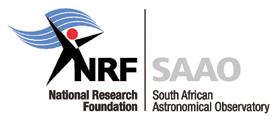
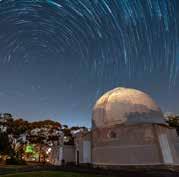
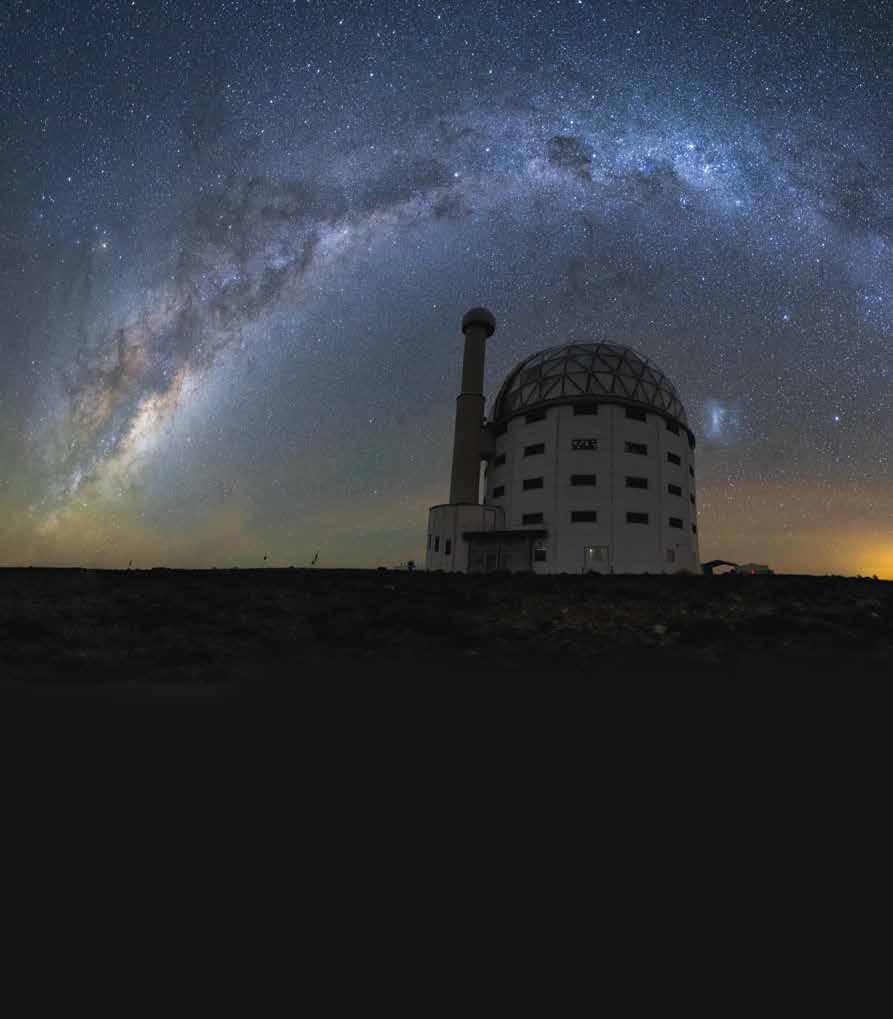
When: 20:00 on the 2nd & 4th Saturday of every month
Where: SAAO HQ, Observatory, Cape Town Cost: Free
Tours include a talk relating to astronomy/ physics, and a visit to the historic McClean telescope, the observatory museum and the library. On clear nights, you’ll also have the opportunity to observe through telescopes set up for the evening.
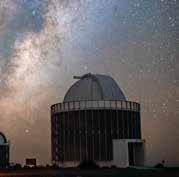


When: Daily, except Sundays & public holidays
Where: SAAO site, just outside Sutherland Cost: R120 (adults)
Visit the SAAO’s facilities in the Karoo! We offer both day and night tours. The site hosts our major telescopes, including SALT, the largest single optical telescope in the southern hemisphere. School tours are also available.
To book, please visit: https://www.saao.ac.za/visitus/ Facebook: @SAAOnews Twitter: @SAAO Instagram: @saao_astro



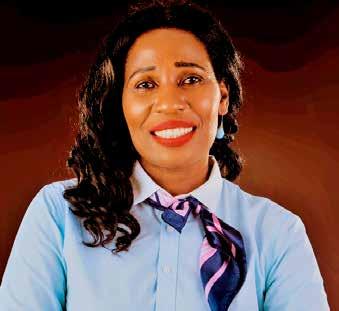
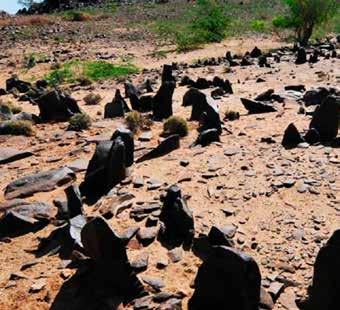


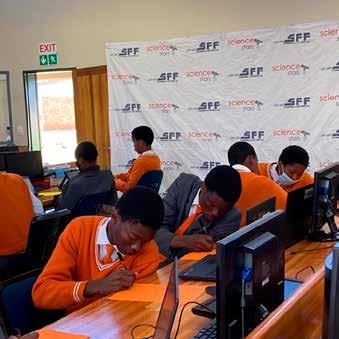
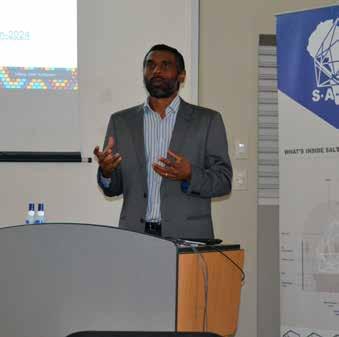
In this edition of African Science Stars, you will notice an active editorial agenda to profile more women in astronomy and leadership positions across Africa. We look at their journeys, from upbringing to how they got into their current careers. The common thread is that many share rural upbringings and an unwavering dedication to their studies. Education continues to prove itself as the key path toward your dreams and climbing up class ladders.
This edition is in no way meant to exclude men but to give them a broader context of some of the challenges women face in accessing the same jobs. We also acknowledge the African Network for Women in Astronomy (AfNWA), an initiative that was established in 2020 with the purpose of connecting women working in astronomy and related fields in Africa. Those connections are bound to be extremely useful.
In South Africa, we recognise the month of August as women's month. Worldwide, women's history month is recognised in March. Does it have to be one month in a year? Why can't every single month be dedicated to women?
Perhaps to highlight why we should recognise and celebrate women, one must look back to history. History has not been kind to women. Yes, in general, history has not been kind to Africans as a whole - we come from a history of being colonial subjects, a history of slavery, a history of marginalisation and a history of collective trauma that has seen our cultures and ways of being destroyed. Has this history changed?
For women, the present is still proving to be the same. If we look at gender-based violence statistics, we recognise that many victims continue to be children and women. Regarding access to opportunities, men still occupy the most senior positions in workplaces worldwide. The same can be said for astronomy and space science.
The older you get, the clearer it becomes that you grow or advance (career-wise) by having extensive networks. We, therefore, have to also work on matters of self-esteem. It is not enough to excel in those STEM courses and graduate cum laude at university. That might look good on your CV, but for one to navigate through their career comfortably, you also have to have social capital or a wealth of social networks in your chosen field.
We need to become social beings again; lift our heads from our computers and smartphones and go back into the world and meet people. Attend events, talk to people, share contact details, find out what others do, let them know what you do and so forth. Keep those connections. Education and social networks are the strongest levers to ascend to ensure a bright future for women and girls.
For us, men, our role then becomes to affirm and support. The ultimate goal is equality and spaces in which we can equally advance our research and development without hindrance. Here’s to more women in astronomy and sciences in general!
 Email: unathi@sciencestars.co.za
Email: unathi@sciencestars.co.za
Women have contributed immensely to the development of their communities, countries and the world. That they may not be afforded the due credit is a debate for another day, but in this issue of African Science Stars, I am happy to note the celebration and recognition of women in their various fields of work across Africa.
Celebrating Women and Women in Science is very important to me since so many wonderful women have inspired me in my life. Women such as my mom, who has always been my number one inspiration.
Scientists such as Prof Ewine F. van Dishoeck, one of the pioneers in Astrochemistry. Prof Anna Scaife, my mentor. Prof Myfanwy Lloyd, my PhD advisor. Fellow young scientists such as Dr Tana Joseph, Dr Bethany May, Dr Benedicta Woode and many others who are constantly inspiring me have helped and influenced my career ambitions.
As a woman in science with an interest in chemistry, I have conducted research in the phytochemistry of plants and their antimicrobial properties, isotope hydrology and hydrochemistry of wetland, and my current research is in the evolutions of massive young stellar objects using complex molecules found in stellar environments. This current research involves observation of stellar objects and theoretical and computational modelling of complex molecules to understand how the stellar objects evolve.
The radio telescope at the Ghana Radio Astronomy Observatory (Ghana Space Science and Technology Institute) is one such telescope used to observe a molecule like methanol in starforming regions in space. The telescope is currently in the works to include pulsar observations also.
Drawing up on my experience in academia and research, as well as my experience as the vice-president of the African Astronomical Society (AfAS), I believe women have the potential to contribute more to the development of their countries and the world.
Women are instrumental in all ways when we consider the development of a nation. I want to encourage all young women and girls to be focused and persistent in their dreams.
They should not limit themselves or believe the limitations put on them by society because they are powerful beyond measure.
In Africa we need our young women to stand up and take a stand for themselves the future is filled with infinite possibilities, especially in the sciences.
*Naomi Asabre Frimpong is a research scientist and vice-president of AfAS. She holds a PhD in Astronomy and Astrophysics (University of Manchester, UK)

For the one who dreams of going to space but can’t quite get there yet, this starry sky projection night light will fire up their imagination and satisfy that desire. This high-definition star light galaxy has eight kinds of mixed nebula effects as well as twinkling green stars. Projected onto the wall and ceiling, it will make you feel like you are right in the vast galaxy itself.
We love that it is designed to look like an astronaut, plus its head and body can be rotated by 360°, so that can adjust the nebula projection angle according to your preference. And it comes with a timer, so you can rest assured knowing that the starry sky projector will automatically turn off when you fall asleep under the stars. Get it for R1099 at Takealot.

The year of the Covid-19 pandemic taught us the importance of good personal hygiene in controlling dangerous viruses and pathogens. So imagine having a product that can keep your phone - and more - sterilised!
Many things make this product worth getting, but we especially approve of no liquid, heat or chemicals being used while mak ing it, which means it’s safe to sanitise anything. All you need to do is put your smartphone into the sanitiser case, press the button for two seconds, and it will quickly disinfect it in 30 seconds. According to its description, “the UV-C light can get to the microorganisms that hide in crevices where even cleaning wipes cannot reach.” Available on Takealot for R599.


This updated barometer is the perfect gift for weather geeks or those wanting to pursue meteorology. The classic little device predicts weather around one to three days in advance. It does this by using crystal formations that change based on impending weather: the crys tals within the sealed glass chamber cluster or disperse with air pressure or temperature changes.
The markings on the glass range from fair and rainy weather to thunderstorms and cloudy skies to indicate the weath er forecast. This classic device rests on a solid beechwood base, won’t crowd up your space and will make a stylish addition to your room or home decor. Find it on Takealot for R390.
“Swipe, twist, roll and click your way to focus”: Welcome to the original Antsy Labs Fidget Cube, which has gained wide popular ity worldwide among adults and teens. The cube is an addictive, high-quality fidget toy designed to help you focus, but it is also perfect for when you’re stressed, anxious, or even just bored. Antsy Labs says it is spe cially designed for calm hands and has six unique sides you can flip, glide, roll, breathe, click and spin into focus and meet all your sediment needs. Available at Toy Kingdom for R149.90 and Sportsmans Warehouse for R179.90


It’s no surprise that drones have taken the world by storm. If you’re looking for an entry-level but quality drone for your travels and explorations, the Sky Speed Quadcopter is a great buy. The set comes with a Full HD 1080p camera, and the drone can also support your mobile phone on its controller for better flight control and rotation. The charg ing time is approximately two hours, giving you a flying time of around 10 to 12 minutes. Besides getting your adrenaline pumping by sending off your drone to zoom around the sky, it can also present you with a money-making opportunity, so consider it a wise investment.
Get it for R868 on Takealot.

Launched in 2022, the Instax Mini Evo allows you the opportunity to share your life’s beautiful memories as a physically printed photo or a captured moment worthy of social media. The innova tive, analogue-style camera features 10 lens and 10 film effect options. This means you have around 100 different ways to create your own unique images instantly!
Experiment with vivid colours, add softness to the focus, adjust the exposure, and alter the white balance. This camera from Fujifilm has it all. Oh, it also has a built-in selfie mirror. Since the camera is compatible with the free Instax Mini Evo app, every photo you print on the camera can also be saved to your smartphone, which you can then share and post to your socials. Available for R2319 on Takealot.
Newly appointed Deputy Director at the Department of Science and Innovation (DSI), Tebogo Mashile, fell in love with Astronomy during her internship at the DSI. Initially, she wanted to study chemical engineering and only developed a love for astronomy after she completed her BSc in physics, chemistry and applied mathematics.
“When I was given opportunities to visit the astronomy facilities in the country, I was immediately fascinated by the work being done at these facilities,” she explained.
Mashile grew up in Limpopo and attended Florapark Comprehensive School. She also received her BSc honours in applied mathematics from the University of Limpopo and a BSc honours in Astrophysics and space science from the University of Cape Town, with her highest qualification being an MSc in Astrophysics.

As a beneficiary of the National Astrophysics and Space Science Programme, a SARAO bursary programme, she says that young women and girls should be taking advantage of such initiatives.
“With South Africa becoming a significant player in the world of astronomy, it is about time young women take full advantage of opportunities which already exist in this field. The SKA is a South African project so young women should equip themselves with the necessary skills.”
It has only been two months, and she is still settling into her new role as Deputy Director whilst learning as much as she can.
She is also a Sunday World Heroic Woman 2021 nominee in the field of ICT and Science. The year 2021 saw her win the Inspiring Fifty South Africa, as well as a motion of congratula tions in Parliament for her MSc that she completed in 2021.
“One thing that works for me is telling myself that I am here to learn, grow as an individual and make sure I do my best in every opportunity given.”
 By: Nadine Sims
By: Nadine Sims
Egypt’s Sara Sabry recently became the first African woman to go to space. She said her trip to space was one of the most profound experiences of her life and she is committed to using it to the best of her abilities to change the world for the better.
“When I saw Earth from space and the vastness of the black universe, I realised how earth and space are not separate - they are part of each other. Earth is in space, and we humans are a part of it - we are here to try to explore it, to understand it and to push humanity forward.”
She was one of approximately 5 000 applicants and was selected and sponsored by Space for Humanity (a non-profit organisa tion trying to democratise access to space for all) to travel to space. The spaceflight took place on 4 August 2022, aboard Blue Origin’s 22nd Mission.




In 2020 Sabry earned her Master’s in biomedical engineering at the Polytechnic University of Milan, in Italy. She is currently busy with her PhD in Aerospace, where her research focuses on space suit design.
She is also the founder of the Deep Space Initiative, a non-profit organisation aiming to increase accessibility and opportunity for space research for all humankind.
Sabry believes that representation in the space field is vital, especially for people from Africa.
“With my spaceflight, I hope that it spikes more interest and motivates younger generations to pursue education and dream bigger than they ever thought possible. This is just the beginning and I cannot wait to see what we do next.”
Trying to get a slot in Basupi Bolo’s diary is no walk in the park as she has a busy schedule that includes a lot of con sulting and research work. She is currently working from Muzira in Zimbabwe but is originally from Botswana.
She was born in Mathangwane Village in Botswana and did her primary school levels at Mathangwane Primary School. She then moved to Gaborone and Lobatse for her high school years, Mahalapye Secondary School and Madiba Senior Secondary School.
Today, Basupi is a space scientist that works as a global leader ship and business coach. At first, venturing into astronomy & space science was a dream that later developed into a passion for space science and technology for her.
“My earlier dreams around working in space were inspired by a picture of Russian cosmonaut, Yuri Gagarin, who became the first human to travel into space. I used to look at that picture and vowed that I too will one day do the same. I later studied space and atmospheric science, and space applications.”

She is currently pursuing her PhD in Information Systems and Data Management at the Botswana International University of Science and Technology (BIUST).
She already holds an MSc in Information Systems and Data Management and a Post-Graduate Diploma in Space and Atmospheric Science obtained from the United Nations African Regional Centre for Space Science and Technology Education in English in Nigeria. She also studied abroad at the United Kingdom’s University of Greenwich, where she obtained her BSc Hons in Geographical Information System and remote. Between all this travelling and studying, she also managed to do short courses in Agriculture and International Development Studies.
Her curiosity about space was further sparked by her need always to want answers to unexplained mysteries happening in space, such as 'What causes a plane to crash?', 'What is the actual distance of things in space?', and so on.
“Whilst studying towards the Postgraduate Diploma in Space and Atmospheric Science, I conducted research on the Impact of a Geomagnetic Storm (Space Weather) on Satellite Electronic devices and Navigation Systems. The research aimed to find out why satellites crash or disappear in space with an unknown fail ure,” she said.
Regardless of being so heavily invested in her education and skills, Basupi has not been immune to challenges around gender equality. Some of the difficulties she encountered was an inabil ity to secure funding to further her studies. She, however, noted that despite doubts, discouragement and other misgivings from the academic wing, she proved them wrong by maintaining the highest marks consistently until she eventually won the trust and academic funding support.
Basupi is also the founder and CEO of GoToSpace – an organ isation established to empower girls, women and communi ties in space and STEM (Science, Technology, Engineering and Mathematics) by mentoring and training them.
She is passionate about promoting STEM and introducing space science to the curriculum to develop an interest in astronomy and space science at the grassroots level. She added that space technology and applications, space tourism and entrepreneurship could be the main space sectors that Africa will benefit most from in future.
“Space technology and applications are one of many important tools that can be used to address Africa’s challenges. Information based from these tools can help Africa improve agricultural yields, manage natural resources, protect habitat loss and stop deforesta tion. Satellite-based data today remains key to fighting climate change and environmental management.”
Entrepreneurship is also a big field of opportunity in the space sciences and astronomy. “Currently, because of space capacity building and awareness in Africa, many space businesses may spearhead start-ups such as space recreational centres, space institutions for training, mentorship, tele-health medicine and tele-education.”
• Africa Director for Enabling Extraordinary Entrepreneurship of UK
Group of 100 Global Women Leaders (G100 Wing) Space Science Technology and Aviation Botswana Country Chair
International Academy of Space Law of Russia Ambassador to Botswana
United Nation Office for Outer Space Affairs Space4Women Network mentor
Space Tourism Society Ambassador to Botswana
Ambassador to Botswana
mentor and ambassador
for Mobile Studies Africa
Technology ambassador
for Good ambassador
Innovation Challenge Expert
of Southern Africa Region of African Union Global Monitoring of the Environment and Security and Africa
Network
“There are various funding opportunities available globally, as well as role models, mentors and educators who are committed to empowering others.”

Picture this: The SAAO auditorium hosting the Astronomy in Africa conference 2019 is swarming with researchers from all over the continent. Now, this is a bolt from the blue: there are so many women astronomers, and it is a joyful moment. Photographers are capturing group photos, and a spare moment sparks Carolina Ödman and Mirjana Porvic's attention at a dinner table as they quickly observe the room's atmosphere. They draft ideas about having Africa’s first women in astronomy organisation and propose this to the AfAS board…
The African Network for Women in Astronomy (AfNWA) is an initiative that once started as an idea, and now seeks to connect women working in astronomy and related fields in Africa. It was established in September 2020. By ensuring girls' and women's participation in the development of astronomy and science in Africa, AfNWA aims to ensure a bright future for women and girls. Their main objectives are improving the status of women in science in Africa and using astronomy to inspire more girls to do STEM. They aim to strengthen and promote participation in astronomy in Africa.

Science and astronomy have always mirrored society through women. “If you could ask a random child what their ideal astron omer looks like, there is a high chance that the child would say it imagines a male”, says Carolina, who is part of AfNWA. Media and culture have emphasised the dominance of male research ers, preventing young women and girls from seeing themselves in this field.
Having the ability to network provides a sense of belonging as we share common experiences even when facing challenges beyond the academic sphere. The ability to interact gives us a sense of community. AfNWA is creating a narrative where a young girl can say, “I can do this because there is someone who looks like me, talks like me and who is doing it!”
The board of AfNWA is pan-African in its coverage and con sists of Mirjana Povic, an assistant professor at Ethiopian Space Science and Technology Institute; Carolina Ödman, a professor at the University of the Western Cape; Vanessa McBride, an astrono mer at the Office of Astronomy for Development, International Astronomical Union; Priscilla Muheki, an assistant lecturer at Mbarara University of Science and Technology (Uganda); Somaya Saad, a professor at the National Research Institute of Astronomy and Geophysics (Egypt), and Nana Ama Browne Klutse, a researcher at the University of Ghana. AfNWA is supported by the South African Department of Science and Innovation through the support given to the African Astronomical Society and the Nature Research and Estee Lauder through Mirjana’s inaugural 2018 Nature Research Award for Inspiring Science.
From winning inaugural awards to hosting workshops during the difficult Covid-19 pandemic and delivering a special talk at the AfAS Conference earlier this year, this initiative is working tirelessly to get the message across.In preparation for the IAU General Assembly 2024 to be hosted in Cape Town, their aim is to prepare a “coffee table book” showcasing inspiring African Women in astronomy and space. Their hope is that the book will raise awareness among astronomers and non-astronomers alike on all the work carried out by women across Africa. AfNWA hopes it will also help the organisation to raise funds for further activities.
For
work
Astronomers Without Borders (AWB) Nigeria has been at the forefront of Astronomy Education Outreach in Nigeria for about a decade now. A group that started out with less than 10 members has since grown to hundreds of volunteers across the country.

The group is bridging the gaps in the educational system where Astronomy is not taught as a subject in elementary and high schools.
AWB Nigeria Network was founded in October 2013. Astronomers Without Borders Nigeria Network is an Incorporated Trustee registered under the Companies and Allied Matters Act of the Corporate Affairs Commission in Nigeria.
AWB Nigeria organises astronomical-based events regularly. Astronomical events, which capture the popular imagination, create excitement and generate media attention. On the other hand, these events represent an unprecedented opportunity for Science, Technology, Engineering and Mathematics (STEM) awareness and support for STEM education programmes. Our organisation uses astronomy to inspire children and as a starting point for continuing STEM education in their schools. Our activities aim to address different social and educational chal lenges in Nigeria. Our activities have addressed gender lopsid edness issues in school enrolment and STEM encouragement for children. Our scope also involves the development of school extra curricula that will drive STEM Education in schools, teacher’s trainings, setting up of Astronomy clubs in schools and other science-based outreaches. We have also been involved with bringing STEM education through astronomy to the less privileged in society through our programme with the children at the Internally Displaced People’s (IDP) camps across Nigeria. We collaborate with some International Astronomy Organisations and local partners to achieve our aims and objec tives. AWB Nigeria brings the world together to share our passion of astronomy and the wonders of the universe. Our observing the skies projects bring people together to share their activities with each other and can be a tool for education, inequality, peace and culture.
Some of the outreach activities include:
The Covid-19 pandemic, which resulted in a prolonged lock down on schools across Nigeria, was utilised by AWB Nigeria to launch the first ever Astro Art Contest in the country. For almost five months, students at all levels remained home as schools remained shut due to soaring infection rates. This maiden Edition of the Astro Art Contest for Elementary and high school kids in Nigeria saw 164 entries sent in by participants from across Nigeria.
The call for entries, which opened on the 8th of July, 2020 saw an extension to the deadline from August 15 to August 31, 2020. The star prizes in this contest being SSVI homemade telescopes (Newton, refractor, two small spectroscopes) signed by the foremost Belgian Astronaut, Dirk Frimout was a great motivation for participants. We received 164 entries which were judged by a team of eight space, astronomy and arts experts drawn from around the country. For the entries submission, participants were expected to make paintings on an A4-sized paper accompanied by a short write up (not more than 150 words) describing their art work.
n the end, six paintings, three in each of the two categories, were selected for the first, second and third positions. Entries were graded on the paintings and motivation stories. The motivation story behind each of these selected paintings were amazing!
We launched our second Project at the Internally Displaced Persons (IDP) Camp on 13th March 2021. This was another solar-powered astronomy learning hub for teaching STEM to IDP kids. This project is very strategic for the AWB Nigeria in her quest to popularise astronomy and use it as a tool to create awareness in STEM among school kids, as well as the disad vantaged kids who have been affected by the insurgency in the north eastern region of Nigeria. This is made possible by the support of our partners; Office of Astronomy for Development (OAD), Cape Town, SSVI and Brussels.
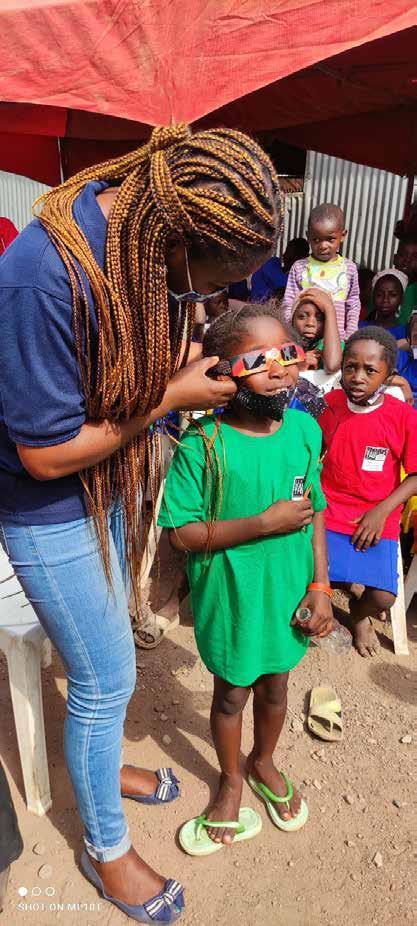
The IDP Children Astronomy Outreach Project aims to use astronomy as a tool to counsel, heal and inspire children that have been displaced due to terrorism in Nigeria. This project has identified astronomy as a tool because it is one of the old est natural sciences. Moreover, the children are used to being taught in an informal setting, so understanding the universe can be passed across suitably to them. Astronomy would prove more effective than other subjects that are based on a structured curriculum.
With the advent of the Covid-19 pandemic, AWB Nigeria sought to support the IDP camp in terms of sharing knowledge of the virus, building a hand wash station, distributing facemask and sanitisers and also equipping the solar-powered learning hub with a desktop computer and android tablets. AWB Nigeria, in her Covid-19 intervention to the IDP children, distributed 300 face masks, 300 hand sanitizers, relief & cleaning materials and also upgraded the Learning Hub that was built one year ago with five android tablets and one desktop computer.
From 10 to 14 June 2019, the AWB Nigeria took a team of high school students from the NAOWA College, Abuja, Nigeria to rep resent Nigeria at the ASGARD IX Project in Brussels, Belgium. They were coordinated to come up with a science experiment involving selected food seeds, which were flown to the edge of space on a high-altitude stratospheric balloon at the Royal Meteorological Institute. The team also participated in vari ous space-related activities during the course of their stay in Brussels. Activities include a guided tour of MIRA Observatory, the Royal Belgian Institute of Natural Sciences, and the Belgium Royal Observatory, among others. The team also had the opportunity to meet a foremost Belgian astronaut, Dirk Frimout who gave a lecture on his flight to the ISS as well as the future of space exploration. AKatrien Kolenberg, professor of astrophys ics, Department of Physics, University of Antwerpen, also gave a lecture on stars. The team visited the Brussels Planetarium where they had the privilege of listening to an astronomy educational lecture.
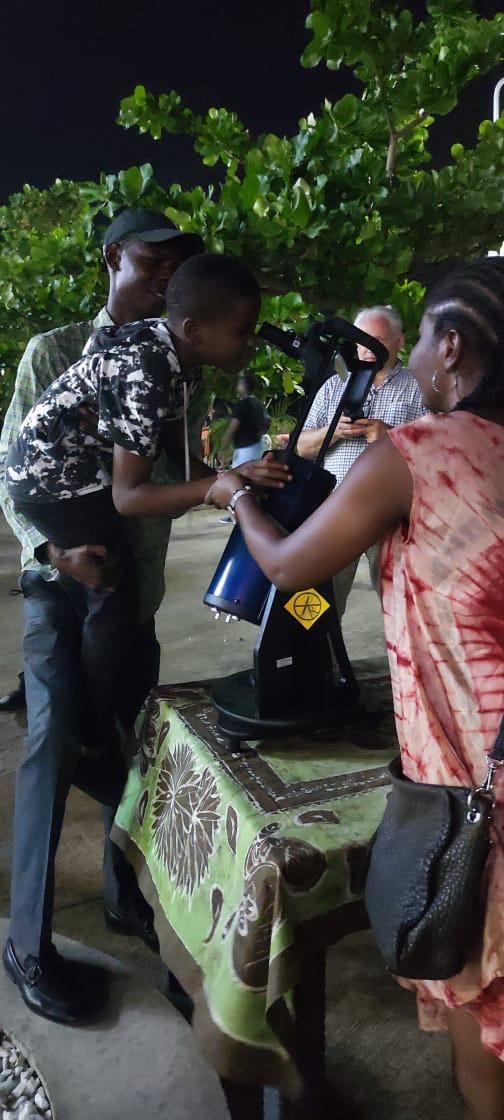
In pursuit of sustainable development in Nigeria, AWB Nigeria organised the 2019 Girls Astronomy camp in Lokoja with the aim of encouraging young school girls to take up STEM education in School.
The camp aimed to make sustainable contributions to inequal ity and quality education. The event took place on 10 May 2019 at Salem University campus, Lokoja, and the programme catered for 200 secondary school girls from different schools within Kogi State.
On 7 May 2022, the AWB Nigeria group held an outdoor stargazing activity to participate in marking the Global Astronomy Month (GAM). This took place in Abuja, Nigeria at the Jabi Lake Mall – a location with beautiful scenery which allowed many visitors to participate in the stargazing event. Many of the guests saw a telescope for the first time and had no idea that the moon looked quite different to how they viewed it in the sky with their naked eye. It was an aha moment. The Chairman of the Board, Astronomers Without Borders International, Dr Tim Spuck who happened to be in Nigeria at the time also graced the event and took part in enlightening the audience about the marvels of space and the bodies/objects out there.

Two members of AWB Nigeria, Mrs Joy Olayiwola and Mr Uche Chukwu, have recorded a milestone achievement with their immense contributions that led to the discovery of the Asteroid 2021-RZ190, which is considered the most eccentric compared to other discoveries by African teams.
This notable feat was achieved under the auspices of AWB, in collaboration with the International Asteroid Search Campaign (IASC) with the aim of conducting worldwide ground and Space based surveys that are geared towards tracking minor planet bodies.
Olayiwola explained in an interview that the asteroid found was a near-earth asteroid (NEA). In other words, it might pose a danger to other planets, especially Earth, if it veers off its orbit. She added that the leading astronomy bodies, such as the International Astronomical Union (IAU) and the National Aeronautics and Space Administration (NASA), have surveys worldwide to track these asteroids.
She further explained that lots of data collected every day during these activities are made available by IAU to people who are passionate about space technology like herself. These images are later analysed and whatever is discovered is credited to the researcher. The discoverer also gets the privilege of naming the asteroid seven to eight years after the discovery date.
More of these exciting outreach activities can be found on the organisation's website at www.awbnigeria.org
The International Astronomical Union (IAU) will host its 32nd General Assembly in Cape Town, South Africa, in 2024 (GA2024). This is the first time in the 100+ year history of the IAU that the General Assembly will be held in Africa, which provides a prime opportunity to showcase the cutting-edge research infrastructure and excellent talent in the science area on the continent.
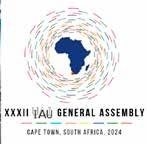

In anticipation of the 32nd General Assembly, the National Organising Committee of the IAU GA2024 seeks to award high impact “Africa 2024” scholarships to eligible African candidates that aligns with the hosting of this historical event. The scholarships will allow excellent candidates to undertake a two-year Master of Science (MSc) degree in South Africa starting in 2023.
The Africa 2024 scholarships will cover international student fees, one international return flight, visa costs, medical insurance, accommodation, and stipend. In addition, scholarship recipients will benefit from the opportunity to volunteer at the General Assembly 2024, giving them an opportunity to interact with the global astronomy community.
African country
Applicants
have liaised
For a good astro-tourism site, you need a few ingredients: clear skies, good weather conditions, and little to no light pollution. Many parts of Africa remain largely untouched in terms of urbanisation, making it the ideal astro-tourism travel site. With urbanisation comes air and light pollution, making it difficult to enjoy the cosmos.

Astro-tourism sites come in many shapes and sizes. Take SpaceX for example, one of the biggest commercial space companies on Earth. When they launch their rockets into orbit, crowds of tourists flock to their launch site in Cape Canaveral.
Or when there is a significant celestial event taking place, like an eclipse or a meteor shower, that specific region can become flooded with tourists. There are also astro-tourism sites, like Sutherland, where you can visit the Southern Hemisphere’s largest optical telescope.


According to Africa Wanderlust, the continent has more than 100 game parks/ reserves open to the public, making it an ideal site for astro-tourists to look up to and enjoy the stars. Africa is definitely astro-tourism rich and will leave you star-struck!

The Namib desert is one of only two sites in Africa (and the first) that has been conferred Dark Sky status in 2013 by the International Dark-Sky Association, making it a go-to site for so-called ‘Dark Sky Chasers’. Namibia also has the High Energy Stereoscopic System (HESS) telescope. Visits to the site are cur rently only by appointment and a visitors’ centre will be set-up in the near future, but is not available as yet.
The first traces of time keeping date back to about 7 000 years ago in the African deserts of Egypt, about 800km south of Cairo. The site, Nabta Playa, is a stone circle, similar but much older than Stonehenge and is thought to have monitored the seasons. It is also considered as one of the oldest astronomical sites in the world.
South Africa has many astro-gems. The Southern African Large Telescope in Sutherland is one and it is the largest optical tele scope in the Southern Hemisphere. This site is ideal for stargaz ing astro-tourists and even astro-photographers. Also in South Africa, the!Ae!Hai Kalahari Heritage Park has also been granted Dark Sky status and measures 21,6 out of 22 on the darkness scale, making it one of the darkest sites on Earth.
Did you know that the Sahara Desert covers approximately 10% of the African continent? It is one of the hottest deserts in the world. With its remote location, dryness and very rare cloud coverage, it really makes for an ideal stargazing trip.
This heritage site is thought to have been built around 300 BC. There are 19 stones that align with seven-star systems and it is thought to have tracked a 364-day year. Like Nabta Playa in Egypt and Stonehenge in England, it is thought that ancient civilisation used them to keep track of time and the seasons, which would have helped with agriculture and food security.


Astro-tourism is the practice of travelling to a site due to its link with astronomy or space-related activities. The tourism industry contributes 7% towards Africa’s total GDP (according to Quartz Africa).
It is the pollution of excessive artificial and bright light. This can come from streetlights, homes, shopping centres and other manmade structures, making it difficult to observe stars, planets and truly experience the beauty of our night skies and the Milky Way.
When I was a student in the early 1970s I presented my first professional talk at a meeting of the American Astronomical Society. It was about a type of pulsating stars. The chair was Professor Martin Schwarzschild of Princeton University, one of the great astrophysicists of the 20th century.
Martin was of German Jewish ancestry, born in Potsdam in 1912. He escaped Germany in 1936 to the USA, where he worked in US army intelligence in WWII and was awarded a Legion of Merit. He also wrote a textbook on the structure and evolution of stars that I had learned from as an undergraduate.
Martin spoke in a loud, forceful way with a German accent. After my short talk he demanded, ``WHAT are these stars’ REASONS to PULSATE?''

I was terrified.
Since I had learned the answer from his textbook, I thought, "If he doesn't know, then what I am thinking cannot be right''. One of the senior astronomers in the audience told him the answer was very simple, and he said softly, "Oh, I missed that." I under stood, on meeting him later years, that he was just being kind in providing a poor graduate student with an easy question.
Martin’s father, Karl Schwarzschild, is even better known. Although he died in 1916 (aged only 42 of an auto-immune disease contracted on the Russian Front in WWI, when Martin was only 4), the year before his death he calculated the first exact solutions to Albert Einstein’s 1915 equations of General Relativity, his new theory of gravity.
Karl found the radius of a black hole where even light cannot escape the stupendous gravity. This is universally known as the “Schwarzschild Radius”.
What is a black hole? The most massive stars die in the “Iron catastrophe”. If the star is too massive, gravity is so strong that nothing can withstand it, and its core collapses to smaller than the Schwarzschild radius where the escape velocity is greater than the speed of light, so nothing, not even light, can escape.

The sun will not, and cannot, collapse to be a black hole. If it could, it would have a Schwarzschild radius of a mere 3 km.
You do not want to get anywhere near a black hole that has the mass of a star. Long before you fall in, its great tides would strip you apart to your atoms, then tear them apart, too.
We detect black holes in binary stars– two stars orbiting each other. We can measure the mass of the black hole by how fast the other star orbits it. We see some stars orbiting something invisible, but with a mass more than 10 times that of the sun.
Only a black hole can be that massive and invisible.
Donald Kurtz is Extraordinary Professor at the Centre for Space Research, Physics Department, North-West University
A galaxy has about 100 billion stars orbiting about their common centre of gravity (our Milky Way is a galaxy). Down in the hearts of galaxies we see stars moving so fast around a tiny invisible point that we know there is a monstrous black hole. The one in our Milky Way has a mass 5 million times greater than that of our sun, yet it is smaller than the solar system. In other galaxies the central black hole can be as big as 6 billion times the mass of our sun!
Those supermassive black holes were cre ated when one star became a small black hole in the centre of a galaxy where the stars are close together. As the black hole encountered other stars, it ate them. A black hole is very much like “The Blob” in the 1958 film of that name (Steve McQueen’s film debut). The more it eats, the bigger it gets.
Giant Black holes produce celestial fireworks on a stupendous scale in what are known as Active Galactic Nucleii (AGNs). They can be seen far away, back to the time when the first stars were born after the Big Bang.

The stars are far away. You see them as they looked long ago because light travels at “only” 300,000 km per second so it takes years or even thousands of years for the light of the stars you can see to reach your eye. And, stars, like us, do not live forever.

Next time you gaze up at the stars in some beautiful dark place, realise that a few of the stars you see may have already exploded as supernovae and died leaving behind a neutron star or black hole. The light is rushing towards us and one day we will see the explosion, the supernova.
Maybe even tomorrow night, so keep looking up.


Every three years the International Astronomical Union (IAU) holds a General Assembly (GA), and this year it was successfully held in the city of Busan, South Korea, with a large African delegation in attendance.
The IAU-GA 2022 attracted more than 2 000 participants and visitors in-person and virtually, with the African delegation con sisting of teams from the Office of Astronomy for Development (OAD), South African Astronomical Observatory (SAAO), African Astronomical Society (AfAS), BRICS Astronomy, Department of Science and Innovation from South Africa, and many others.
Under the theme of ‘Astronomy for All’ the aim of the GA is to bring everyone in the field of astronomy together to network and share knowledge. This was done through presentations, panel discussions and different booths from astronomy organisations across the globe.
The talks and panel sessions were particularly informative and engaging, explained Duduzile Kubheka, BRICS Astronomy Project Coordinator. “They certainly motivated people and organisations to be more innovative in their efforts and contributions towards astronomy research, outreach, education and sustainable development.”
The ‘African booth’ was also beautifully designed. “It kept all the delegates engaged about astronomy in Africa and the expertise that our beautiful continent has contributed to the advancement of astronomy and many other things that Africa still has to offer to the global audience,” said Kubheka.
In true African style, the booth was lively, with the team singing and dancing to the sound of Jerusalema, so much so that other delegates would also join in the festivities and fun. Kubheka said, “There indeed were special moments, one that brought people from all over the world together in three languages we all speak and understand - song, dance and laughter.”
The next GA will take place in 2024 in Cape Town, South Africa and this will be the first time the IAU-GA visits the African conti nent. To celebrate this, on the last day the entire African delega tion dressed in traditional attire to welcome the handover of the IAU flag.
Kubheka said: “We showed the world the true African spirit, seen through the togetherness, diversity and love shared among each other and everyone who crossed our path. We were inspired by the many events and activities that took place in Busan and we returned home with the flag and ready to work.”
Welcoming global astronomers from the 5 to 16 August 2024, the city of Cape Town is known for its natural beauty, vibrant and friendly culture and numerous international tourism accolades.
The city and surrounds also play host to a variety of world-class astronomy facilities and organisations that include the South African Astronomical Observatory, the South African Radio Astronomy Observatory, the Inter-University Institute of Data Intensive Astronomy, the African Astronomical Society, the IAU Office of Astronomy for Development and the Iziko Planetarium, as well as multiple universities with strong astronomy programmes.
The IAU-GA 2024 will be hosted by South Africa’s National Research Foundation and is receiving strong support from the South African Department of Science and Innovation, which is champion ing the development and growth of the multiwave astronomy community in South Africa and across Africa.


For many, this will be a first opportunity to visit Africa. The organising com mittee is already planning initiatives that are sustainable, inclusive and will have a lasting impact. Whether you are coming for the astronomy and staying for the splendour, or the experience and staying for the science, the programmes in development, education and sightseeing will leave an impression on visitors and locals alike.
will be the first IAU-GA to take place on the African continent and the next two years of planning and organising have begun.
As said in the words of Galileo Galilei: “I have loved the stars too fondly to be fearful of the night.” These words are a precise definition of my upbringing. Every night in my small village of Taung, in the North West, I would go out around 6pm and set my eyes to the heavens and gaze up at what I thought were “stars”.
Little did I know that among those stars were planets, galaxies, asteroids, planetary nebulas and many more. I remember during one of those faithful nights, 6 August 2015, I looked up and saw showers of what, at that time, I thought were “shooting stars”. I took a personal decision that I want to learn what those things were, what made them move like that and why they disinte grated after a while, and where they disin tegrated into.
My name is Karabo Rantwane. I am 19 years old and am a physics and astrophys ics undergraduate student at the University of Cape Town. I am currently doing my second year in the department.

As mentioned in my introductory paragraph, I have been stargazing for a while since the days I was introduced to the subject of astronomy. Stargazing in South Africa is a big thing, in particular my village of Taung, where there is little light pollu tion relative to other parts of the country. It is this advantage that I took to look up and see funny patterns that stars made. Of course, we do not have professional instru ments like telescopes or binoculars or a professional building like an observatory to to conduct stargazing, such as the SAAO (South African Astronomical Observatory)
in Cape Town or the SALT (South African Large Telescope) in Sutherland, but I am grateful for my own pair of lenses or bin oculars which are my eyes. To make it even better, conditions are just right here in my village to allow for the splendour of the universe to show up, bragging in awe right in front of my eyes.
The biggest thing I appreciate about my community is that it is set at a latitude and longitude that allows me to appreciate the sight of stars that have a declination of approximately -630 to -900, which are always visible from my community through out the year. Those with a declination of -620 to +620 are visible during other parts of the year. All the ones I am about to mention can be seen with the naked eye during a clear, dark night.
These include famous ones such as the Southern Cross (always visible from my community). For people in my community, they used this constellation when it was at its highest point in the sky to mark the start of the rainy season. The Zulus were rather sophisticated in their view of the Southern Cross as they used it as a map to find their way inland. For the Constellation of Orion (visible during the period from December to March in Taung ), it is the most well-known in the tribe of the Sotho people, with the rise of this constellation attributed to good omen. When it appears in the sky, they declare that something good is going to happen.

The other constellation visible in my country during the same period as the Orion Constellation is the Pleiades (also known as the Seven Sisters). For the Tswana people in my community, the appearance of this Constellation marked what they called Selemo, which translates to Summer. This constellation is just as famous as the Orion Constellation for people in my community as my elders claim that they used the appearance of this constellation to mark the right time of the year for agricultural purposes. For the Zulu people in the KwaZulu-Natal, the Pleiades also marked the beginning of a new year and for the Tswana people, the start of agricultural season, where they had to plough.
Other famous stars are seen in my community during different parts of the year, including the brightest stars in our night sky, Sirius. Also found in the Constellation of Orion is Betelgeuse, which is set to explode when it reaches the end of its life in the near future, meaning it will provide a beautiful sight to see for people in South Africa, as well as Proxima Centauri, which is the closest star to us other than the sun at 4.2 light years away. To brag a little, there is a constellation named after our beautiful Table Mountain called Mensa. What is special about this constel lation is that it is the only one named after a real geographic feature on Earth and we have Table Mountain to thank for. This constellation is also a beautiful sight to see from the night sky of South Africa.
Planetary Nebulas, such as Orion Nebula can also be seen during a clear, dark night from my country. As mentioned earlier, not only do the heavens provide sight to stars, but also planets. Therefore, well-known planets in our solar system can be seen in my com munity, such as Jupiter, Saturn and Mars (visible during December) and Venus, the most famous planet in my country, due to its brightness. For people in my community, they call it with differ ent names such as Mphatlhalatsane and Naledi ya Moso which all attribute to Venus being the brightest celestial object in our night sky and being the first one to rise as dusk, and the last one
to set at dawn. I was taken by storm when I heard people in my church singing about it. This is just clear evidence that in my country, we are People of the Sky. Also, for the Zulu people, they did not see Venus as the same celestial object, calling it the Evening Star (Isicelankolobe) and Morning Star and rec ognised these as the wives of the Moon. They believed that the Evening Star feeds the Moon badly, resulting in the Moon becoming thinner while the Morning Star feeds the Moon well, resulting in it becoming bigger.
Last but not least, I would like to mention that I like living in a universe that is big. Therefore, I like to mention that the Band of the Milky Way Galaxy can be seen from my village on a clear, dark night. This is the whole disk of the Milky Way Galaxy unfolding right in front of our eyes. For me, this is the most beautiful sight I can have from stargazing in my commu nity, only because of the compactness of stars, planets, aster oids, and planetary nebulas and dust, which are light years apart, but all seem so close to each other when observed from here. I am therefore intrigued by this splendour of beauty and knowing that I am part of such vastness of the cosmic sea, to which only my eyes can extend to see, I dream to know what lies beyond that horizon.
In conclusion, my country offers a wide variety of celestial objects to see on different nights of the year during a stargaz ing session. The ones I mentioned is only a fraction of the things to see. I am convinced that my country, and in particular, Taung, would make a very good site for astronomical obser vations and research. Taking into consideration the weather, latitude, altitude and pollution from light and smoke, it pro vides just the right conditions to soak in the beauty that the universe has to offer.
For me, studying astrophysics and learning about the things I mentioned, just fuels that desire to want to utilise what stargazing in my community has to offer, and not just for me to enjoy it, but to impart this knowledge of the cosmos to others in the community so that when they hold their heads high and point to any part of the sky, that they may know what they are pointing to and feel the fire in them as I do because, truth be said, the Universe Belongs To Us All.
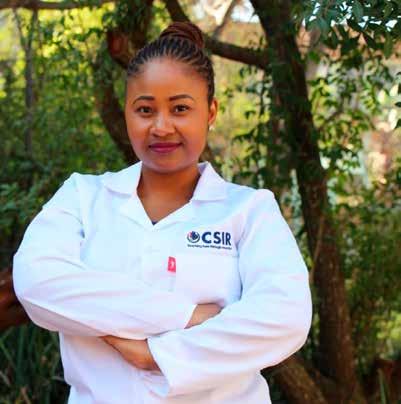


Vuiswa Lucia Motsa is a process technologist at the Council for Scientific and Industrial Research (CSIR). She is registered with the Engineering Council of South Africa as a candidate engineer ing technologist. She started her career at the CSIR in 2019 as an intern for the Bioprocessing Development Research Group and was appointed as a process technologist in the CSIR Advanced AgroProcessing group in 2020. she completed her MTech degree in chemical engineering at the University of South Africa. Her research within the Advanced Agro-processing group focuses on optimising South Africa’s biodiversity by formulating high-value products, such as food and African traditional medicines, based on indigenous plants.
Alma Truyts is a candidate researcher at the CSIR. She holds a Bachelor of Science degree in Microbiology and Biochemistry, and a Bachelor of Science Honours degree in Molecular and Cell Biology from UCT. She started her career at the CSIR as an intern and was then retained by the team on a Master of Science studentship, work ing with collaborators at the University of Pretoria, to develop a point-of-care diagnostic for tuberculosis (TB) detecting unique bio markers. She completed her Master of Science in Biotechnology describing several unsuccess ful methods for the TB diagnostic test. In 2020, she developed a breakthrough method to detect the unique low affinity biomarkers for TB using an established point-of-care diagnostic technology.
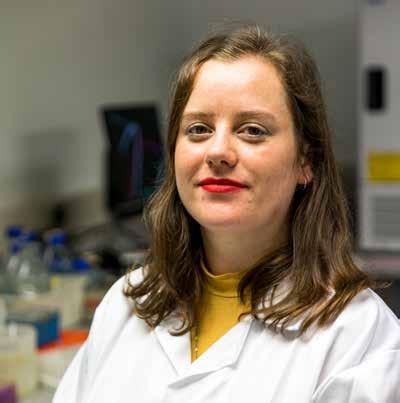
Vivey Phasha is a technologist at the CSIR. Her primary research focuses on the development, formulation, and safety testing of personal hygiene, hair, and skin care products. She recently completed a Master of Medical Science degree (in Medical Biochemistry) at the University of KwaZulu-Natal. Her study focused on addressing skin pigmentation by using a fungal derivative in a dermatological formulation.
In 2018, she completed a post-graduate diploma in Cosmetic Product formulation with a distinction at the North-West University. The composition of the qualification focused on various aspects of chemistry, pharmacy, skin anatomy and physiology. She also holds an Honours degree in Formulation Science from the Nelson Mandela University, where she gained knowledge and understanding of blending and mixing various components. She acquired various formulation skills for products such as personal care, household chemicals, pharmaceutical, food, and water treatment products.
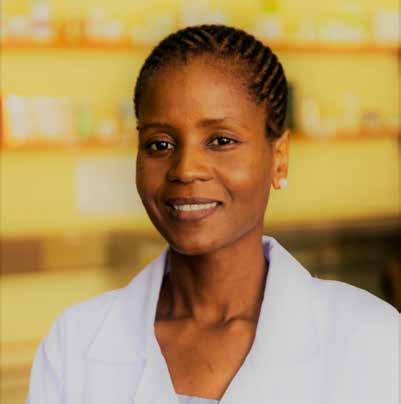



The new year celebration on the night of 31 December is one of the most celebrated events in Africa and the world. New Year’s Eve serves as the time of reconnecting with family and friends. Individuals reflect on their yearly journey and, after that, set new year’s resolutions.
In Africa, the new year is celebrated in the middle of summer, just five days from the summer solstice - the longest day in the year. You may ask yourself if I am not mistaken and whether the new year is actually supposed to be celebrated during the Spring
Equinox. Fair enough. This article will discuss issues of misalignment, the civil calendar and rhythm of nature.
As the Earth revolves around the sun, it passes through phases: Spring Equinox, Summer Solstice, Winter Equinox (equal day and night) and Winter Equinox. These four phases form four seasons in a solar year. However, due to a 23.5-degree slanted rotational axis of the Earth with respect to a vertical NorthSouth axis, the North and South Hemispheres experience these seasons in a flip order. This means that when it is summer in the Southern Hemisphere, it is winter in the Northern Hemisphere. For example: Spring Equinox 2022 in the Southern Hemisphere will be at 03:03 on Friday, 23 September. During the Spring Equinox the sun returns to the South Hemisphere, which marks the first day of the spring.


A calendar is a tool that helps humans keep track of the motion of the Earth with respect to the Moon’s (Lunar calendar), Sun’s (Solar calendar), and nearby stars (Stellar calendar) motion and positions.
The most ancient calendar in the world is called Inzalo yeLanga, also known as Adam's Calendar, which is located in Mpumalanga (Phuma (emerge) + Langa (sun), South Africa. Great Sanusi Vusamazulu “Credo” Mutwa taught that the Inzalo yeLanga was used by Ancient Bantu people to track the motion of the sun, Sirius, and other constellations. He continued to narrate that the begin ning of the year was marked by the heliacal rising of Sirius star at dawn at Spring Equinox, which occurred on 23 September in the Southern Hemisphere.
Therefore, a grand celebration of the new year occurred at Inzalo yeLanga (birthplace of the Sun), where people officially welcomed the Sun in the Southern Hemisphere.
The Zindzi Mandela Foundation and Great Empire of Kemet are organising this year's new year celebrations at Inzalo yeLanga, on the 23 September 2022; for details please check their web site and social media platforms. The Zindzi Mandela Foundation and Great Empire of Kemet have been advocating for the revival of the African Calendar and have developed a digital calendar which can be found on their website: https://gekmovement.org/
What about other regions in Africa? When did they celebrate the new year in pre-colonial times? Most Southern African Bantu people celebrate their new year around August-September. The weather conditions guide the beginning of the celebra tion. For example, the amaZulu new year begins in August, in a month called Ncwaba, and the new year is celebrated in September, in the month called Mandulo, where the festival of Nomkhubulwane is celebrated - the Moon Goddess of fertility and wisdom. In pre-colonial Zulu culture, this festival marks the beginning of farming. Such an event is not unique to Zulu but celebrated in Southern Africa amongst Ndebele people in Zimbabwe, Ngoni people in Namibia, Zambia, Tanzania, and Malawi.
Ethiopia celebrates the new year on 11 September. Ancient civili sations like Kemet and Nubia celebrate their new year around 4 July through the marking of Nile floods, and later through the helical rise of Sun and Sirius in Spring Equinox, 23 September. Ancient Egyptian, Kemet, developed one of the world’s sophisti cated zodiac calendars, called the “Dendera” calendar found now at the Louvre Museum in Paris, France.
Many ancient astronomical sites are distributed throughout Africa. For example, the stone circles in Senegambia in Gambia and Nabta Playa in Egypt, to name a few. A more detailed discus sion of the culture of astronomy in Africa is presented in a book called African Cultural Astronomy: Current Archaeoastronomy and Ethnoastronomy Research in Africa. The question remains, what happened to this astronomical accurate new celebration culture?


The colonisation not only took the land away from African people but also disrupted their culture and spirituality. Most African states use Gregorian Calendar, a Roman church devel oped by Pope Gregory XIII in 1582. Pope Gregory's calendar revision attempted to fix an inaccurate prediction of the Julian calendar's Spring and Winter Equinoxes. The solution of Pope Gregory XIII was to introduce a leap year system to correct the Julian calendar. Even in the Northern Hemisphere, the year began
on 21 March, during a spring Equinox. In any case, the Julian and Gregorian calendars align more with the Northern Hemisphere seasons. In all fairness and the spirit of synchronicity, African people must stop using the Northern Hemisphere-based calen dar. Why? First, they have their calendar systems, and secondly, the Gregorian Calendar is misaligned with Southern Hemisphere seasons. Therefore, a proposed New Year celebration could be on 23 September on the Spring Equinox, which be on Friday, 23 September 2022.
mention that
reviving
beyond

Africa's future
as
astronomically bright.

From an early age Dr Sinenhlanhla Precious Sikhosana knew that she wanted to be part of the science community and make groundbreaking discoveries. With many accolades and awards under her belt, she is doing just that and is also passionate about being a role model to draw young women to astronomy.

Sikhosana grew up in rural KwaZulu-Natal, South Africa, in a village called eXambu. It was only in her matric year that she was exposed to the field of astronomy as a career choice and it appealed to her immediately. She explained, “The UKZN postgrad students passionately shared how they were trying to solve the mysteries of the universe and I was instantly sold.”
She then went on to complete her schooling at Durban Girls’ Secondary School and subsequently went to study at the University of KwaZulu-Natal (UKZN), completing her undergradu ate and postgraduate studies at the institution. Currently she is a SARAO postdoctoral fellow, based at UKZN. In March, Sikhosana was nominated by her colleagues to be part of the African Astronomical Society’s (AfAS) executive committee. She says that it was more than a nomination for her, it was a symbol of acknowledgement. With this position she hopes to get involved with various outreach programmes and hopefully be able to reach even the most remote villages on the continent, just like the one she is from. She explained, “I think every African child needs to be exposed to astronomy at an early stage, only then will we be able to remove the stigma that astronomy is a science only reserved for the elite.” She acknowledges that the astronomy field is still largely male-dominated and she hopes to get more women and girls to break into the field. Sometimes it just takes a person who ‘looks’ like you to make you believe you are capable, she remarks.
Dinelsa Machaieie, Auxiliary Professor at Eduardo Mondlane University in Maputo, is at the forefront of promoting gen der equality in underprivileged areas in Mozambique, using astronomy. Machaieie, who grew up in Maputo city and did her education at Francisco Manyanga Secondary School, did not always want to be an astronomer. It was her passion for physics that pulled her in that direction and after finishing her Masters degree in Physics, she wanted to continue her studies in an area where she could apply the knowledge she acquired.
After her PhD, which she completed in Brazil, she became the first astrophysicist with a doctorate in her department and her country. Machaieie believes that being an astronomer has brought out the best in herself and young women, and girls should also consider this fascinating field of study.
“In general, I think that girls should pursue careers in science fields, because they are challenging and make us seek to be our best to solve related problems. During this process of doing science, we work on our creativity and improve our skills.”
The project Machaieie is currently working on is called “Let Me Be Part of the Universe”. Its main objective is to promote gender equality in areas of the country that need it the most, and this is done through astronomy.
Machaieie explains that sometimes young girls and women grow up without knowing positive female role models that are engaged in the sciences, and she wants to change that.
“It is important because it will allow the pupils and their parents to see that there are other options for girls; they can be astrophysicists or pursue careers in other STEM sciences. In general, they can change the world.”
“Everyone at some point has looked up at the stars with an amazed gaze filled with curiosity; young women should have the opportunity to participate in curiositydriven research which will equip them with skills they can even transfer to their community.”
This year marks the 10th year since the world found out that South Africa and Australia would co-host the Square Kilometre Array (SKA).

When Professor Justin Jonas, Chief Technologist at SARAO, first heard the news that South Africa would co-host the SKA tele scope, he was shocked. His first thought was: “Oh dear, this is going to be a lot of work!”
Jonas explained that South Africa and Australia both had com petent sites, as well as the right people to execute a task of this magnitude. He already knew that there would probably be a split site solution but insisted it shouldn’t be called a compromise.
“I don’t consider it to be a compromise, I consider it to be a very pragmatic way of ensuring the success of the project. It retired many risks that were going to be associated with allocating everything to one country.”
He also said that the reason they were as successful as they were during that time was because their emphasis was always on delivery. When they said they’d do it, they would do it success fully.
“I think that’s been the basis of why we have a lot of buy-in and cooperation. To be honest, we were lucky in many ways, but as they say, luck favours the prepared. And I think we had done our preparation well and, importantly we hired very good, very competent South Africans.”
In June 2021, the final construction was approved and given the go-ahead. When asked why it took as long as it did, Jonas explained that there had never been a hiatus or lack of activity. The project had just been in a ‘pre-construction’ phase and was building a solid foundation.
Takalani Nemaungani, Chief Director of Astronomy at the DSI, also explained that SKA is a high-tech, complex instrument and the technology required is not something that can be bought off the shelf. It actually has to be developed.


Nemaungani adds that the time was also used to raise the funds: “It meant that the SKA had to recruit more countries to join because the more countries you have, the more money you have. And you can only begin construction when you are quite certain you have a sufficient number of countries that have committed funding to make the telescope a reality.”
Developing a solid organisation is another part of the process that took a lot of time. SKA Observatory is a treaty organisation, which means each country, through their government, agrees and guarantees financial, legal and administrative support to the project.
MeerKAT, the precursor to SKA, consists of 64 dishes and is one of the most sensitive telescopes in its category, globally. Once SKA is fully integrated, there will be 197 dishes in South Africa.
Jonas explained that he was recently asked what percentage of users of MeerKAT are from South Africa. He said it was quite a good percentage. It is less than 50%, but all things considered, it is still quite a good percentage.
“It’s a bit of a double-edged sword, if we had built a not-so-good radio telescope, nobody in the world would want to have used it. And it would have been 100% South African. It’s an interesting balance and that’s a subtlety that perhaps is often missed.”
“People are used to coming to Africa to work with our wildlife, with our biodiversity, with our very complex cultural and other sociological issues. But here, they are coming to use something that was built by Africans and of course I would say it’s a good news story,” he mused.

Nemaungani said the expected construction period is said to last about seven to eight years, making the expected date of seeing first light around 2028 - 2030. The SKA telescope will have an expected lifespan of 50 years.
SKA is an acronym for Square Kilometre Array, which means when the project is complete, astronomers will be able to observe one million square metres of the sky at a time. The radio telescope consists of antennas in both South Africa and Australia and is considered the world’s biggest, collaborative science initiative. It involves organisations from 14 countries that are members of the SKA Observatory.
African Science Stars magazine would like to congratulate MS Grace Katusiime, Dr Hassan Abdalla and Ms Malebo Ella Moloko who each walk away with 1 200 Euros for international/domestic travel, lodging, computer equipment and other research-related expenses.

About the winners:
MS GRACE KATUSIIME
Mbarara University of Science and Technology, Uganda Research Project: “New ideas from old friends: revisiting XTE J1118+480 and XTE J1550-564.”
Omdurman Islamic University, Sudan Research Project: “Infrared emission from interstellar dust in cosmic voids affecting the TeV gamma-ray flux from distant blazars.”

Ms Malebo Ella Moloko
University of Cape Town, South Africa Research Project: “MeerLIRGs: A 1.28 GHz MeerKAT continuum study of Luminous Infrared Galaxies in the Southern Hemisphere”
The AfAS Seed Research Grant was launched in 2021 by the AfAS EarlyCareer Researcher Sub-Committee under our Science Committee, the AfAS Seed Research Grant supports research projects in Astronomy (including Astrophysics and Space Science) conducted by postgraduate students and/ or early career researchers that are based in Africa.

Science Stars NPO has partnered with the Strategic Fuel Fund Association (SFF) to bring a coding and robotics programme to 25 secondary and high schools across the Mpumalanga Province.

Founded in 2009, Science Stars NPO is a community development organisation that promotes the awareness of Science, Technology, Engineering and Mathematics (STEM) to young people in historically disadvantaged communities.

This flagship programme, which is being done in partnership with the Mathematics, Sciences and Technology Academy (MSTA) was rolled out in March this year. MSTA is an entity of the Mpumalanga Department of Education to increase the number of learners taking MST subjects and to improve the quality of the passes in mathematics and physical sciences.

In this programme, the MSTA provided the schools that have been identified to do coding and robotics from all four school districts in Mpumalanga. This partner ship also made it possible for Science Stars to access the schools and learners. It will impact approximately 3 000 learners in non fee-paying schools where it is needed the most. The programme is the first of its kind in the province and seeks to stimulate the interest of learners in the technol ogy field, while also building a pipeline of scarce computing skills that are lacking amongst the youth.
The facilitator is Dr Tshinakaho Seaba (Project Coordinator), who holds a Doctor of Computing in Informatics, Information and Communication. Dr Seaba deemed the coding and robotics programme to be appropriate and timely due to the speed of technological breakthroughs towards and beyond the Fourth Industrial Revolution (4IR).
The programme has also got approval from partners like the Department of Education in the Mpumalanga province through the MSTA, the University of Venda and the Department of Science and Innovation. SFF is currently the programme's major donor.

It doesn’t stop there – the NPO has also established coding and robotics clubs, providing learners with access to the latest cutting-edge technology and supports learners and teachers throughout the education system, all in the hopes of creating a culture of innovation among the youth!

The Science Stars NPO team also hopes that the success of the programme can lead to its expansion and subsequent roll-out to other provinces in the years to come and eventually across the rest of the country.
For more information about the programme, how to get involved or donate, visit the website: sciencestarsnpo.org or email: info@sciencestarsnpo.org
“The programme is a fun introduction into the tech world as it hones learners’ coding, automation, problem solving, computational and critical thinking skills”, said Dr Seaba.

Ms Maruping, who is currently SARAO’s Deputy Managing Director responsible for Operations and Business Processes, will, from 01 October 2022, take over from Dr Rob Adam, who has served in the position for seven years.
The NRF’s CEO, Dr Fulufhelo Nelwamondo, said Ms Maruping brings to this portfolio a wealth of leadership skills, strategic thinking, extensive stakeholder management experience and a passion for complex technology sectors, having worked for organisations such as the Technology Innovation Agency, Mine Health and Safety Council, the then Department of Science and Technology, De Beers Consolidated Mines, and currently as a board member of Mintek.
Until recently, Ms Maruping also chaired the South African Council for Space Affairs, and the Scientific & Technical Committee of the UN's Committee on Peaceful Uses of Outer Space.
“We congratulate Pontsho on this appointment and are confident that her experience and expertise will stand her in good stead to make a significant contribution to the NRF and its strategic objectives,” said Dr Nelwamondo.
Dr Adam, who will serve in an advisory capacity for a further year, said: “I worked with Pontsho on and off for many years, first in the Department of Science and Technology (now the Department of Science and Innovation) when I was Director-General, and she
has always impressed me with her dedication and professional attitude to work. I am very optimistic and look forward to ensuring as smooth a handover as possible, in whatever way I can.”
SARAO is a facility of the NRF responsible for managing all radio astronomy initiatives and facilities in South Africa, including the MeerKAT Radio Telescope in the Karoo, and the Geodesy and VLBI activities at the HartRAO facility in Hartebeeshoek, Gauteng. SARAO also coordinates the African Very Long Baseline Interferometry Network (AVN) for the eight SKA partner countries in Africa, as well as South Africa’s contri bution to the infrastructure and engineering planning for the Square Kilometre Array Radio Telescope.
The National Research Foundation (NRF) is an independent statutory body established in accordance with the National Research Foundation Act. Its mandate is to support and pro mote research through funding, human resource development and the provision of the necessary research facilities in order to facilitate the creation of knowledge, innovation and devel opment in all fields of science and technology, including indig enous knowledge; supporting and promoting public awareness of, and engagement with, science; and promoting the develop ment and maintenance of the national science system and support of Government priorities, thereby contributing to the improvement of the quality of life of all South Africans. Website: www.nrf.ac.za | Twitter: @NRF_News | Facebook: @NRFSouthAfrica

 By: Lusanda Tamesi
By: Lusanda Tamesi
Known for its large rivers, fascinating flora and fauna and freshest waters on the continent, Uganda the “Pearl of Africa” will make its first appearance in space.

Yes, you heard us right, Uganda's first space program is coming to life! With the approval of funding for a ground station near Kampala (Uganda capital), the project which was first announced in 2019, has recently taken a major step forward. “PearlAfricaSat-1” - 10 cubic metre satellite is what I am referring to. This satellite is earth’s first orbiting satellite from Uganda.
Let’s break down the name’s origin: PearlAfrica comes from “Pearl of Africa” as described by Sir Winston Churchill during his first trip to Uganda. In Churchill’s book My African Journey, he marvels at the country's canyons, rivers and wildlife. Sat is the acronym for Satellite. 1 refers to the number of times it has been launched.
The building of PearlAfricaSat-1 started two years ago. The project started at Mpoma (the central Ugandan district of Mukono), a facility where there are two antennas that will serve as operations and communications centres for satellites launched by the government and universities.
The Mpoma satellite station is a station that tracks and commu nicates with orbiting satellites. The existing antennas are associ ated with Intelsat’s Atlantic Ocean and Indian Ocean. A collaborative research initiative was agreed upon by the Ugandan government and the Kyushu Institute of Technology (Kyutech) in Japan. As part of the agreement it states that the three graduates involved namely; Edgar Mujuni, Derick
Tebusweke and Bonny Omara would be involved in upskilling them to design, build, test and launch the satellite. These three students completed the development work on PearlAfricaSat-1, which was then handed over to the Japan Aerospace Exploration Agency (JAXA) for final testing this year. You are probably won dering, “What is PearlAfricaSat-1’s mission?” The spacecraft will conduct research and observation in six major areas, including meteorology, land mapping, water and mineral mapping, agri culture monitoring, infrastructure planning, border security and disaster prevention. Data will be sent to Mpoma's ground station as a way of reaching a wider audience within Uganda.
Uganda’s government is putting plans in place for the country's technological development and it is said that Uganda will get to be listed alongside South Africa, Egypt, Nigeria, Ghana, Algeria, Morocco, Ethiopia and Kenya for their innovative space pro grammes.
 By: Nadine Sims
By: Nadine Sims
The United Kingdom National Space Academy and the South African Space Agency (SANSA) jointly held a programme where the two organisations worked with students and science clubs to present an exciting week filled with all things space and science related. The UK team came prepared for a week filled with entertaining and exciting talks, demonstrations and practical experiments. The partnership started in 2021 and has grown from strength to strength.
The aim of the UK National Space Academy is to support schools to boost student attainment, and to support teachers by giv ing them extra activities and resources to add to their standard teaching toolkit, and to help young people better navigate their way into career pathways in the science and engineering sectors. The programme started off with talks in the morning all about astronomy and optics by Prof. Nigel Bannister from the University of Leicester. Then Prof. Anu Ojha, the Director of the UK Space Academy, showed the budding scientists a space suit and demonstrated how it works, with students able to try on the different parts, like the arms. Sophie Allan then took over and introduced the students to radio waves, space and its expanse. Thereafter, everyone got to put their rocket science skills to the test and built a paper rocket, launching it to see which flew the furthest.
SANSA Communications Practitioner, Daleen Fouche expressed her excitement about the UK Space Academy’s visit and also said that the relationship is not one-sided – there are plans for an exchange programme. The SANSA team will join the UK team in the near future to share their knowledge of science engagement and how their outreach and engagement within communities are done. Hopefully this will take place later in the year or early next year, she said. Allan also said that the entire team had a great experience and all of the students were engaging and attentive.
All of the schools and science clubs that participated come from the Hermanus area, where the SANSA regional offices are locat ed. The week-long activities also ended on Saturday with the UK National Space Academy exhibiting, demonstrating and engaging with the local community at the local Whale Coast Mall.


You can meet the UK National Space Agency outreach team who will be coming back to South Africa to participate at the SciFest Africa in September this year!

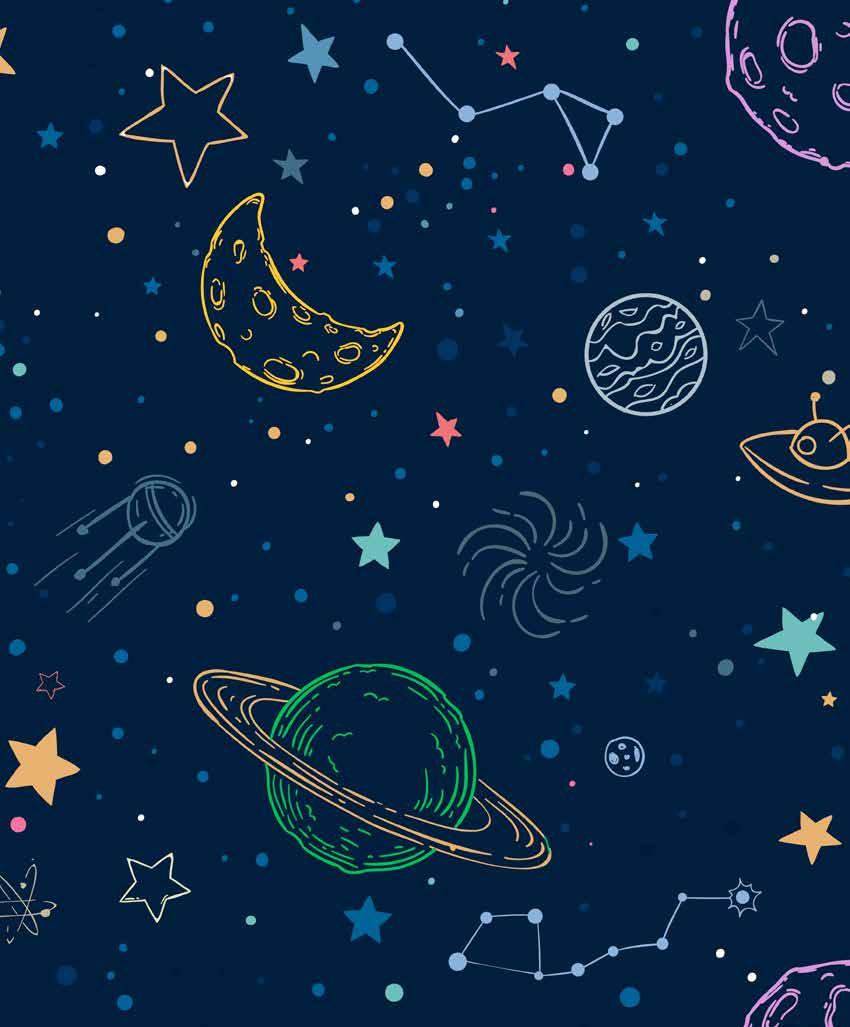


D E J P D O P V K F S L S Q N S D Y E S
Z X A E I E R V S K A V E D D N L J K P
A O R P M T T B A M U A P M F S A J S E
R P G N D P Z E I B W B L B P S G P H C
Z L T Y C D R W C T L X X D I U R I S T
M A U N C J Y K T T H B N M C N A R E R
J N R B T R H F Z H O V E V J S N W G O
I E U U E Q G G H R H R D Z C H G A M G
C T Z I L R G I A C Z M O I U I E H E R
R N Y R E R Y C B L G G E A L E P O N A
R F U V S E Z L Q K A G S F M L O H T P
D W N V C Q M T L I S X A K Q D I E S H
F M G G O R K W Q I W X I T E Q N X U G
Z N I U P T P T R H U B T E P T T A Q O
W Q V R E W H V X I O M I K S N L G X L
L G Y G R V R D Y Q M M C G Z L W O N D
X S B D Q O Y C S T J J V C S L N N A G
M J U Q W G R P I O R P D G W W V A S I
A R I A N E F I V E J G E O L B L L A C
T W Z I N F R A R E D P R C A M E R A I
The first few days of August were one to remember! National Science Week made a strong return after the pandemic. The African Science Stars team showcased and engaged with science communicators, high school learners and the community of Umlazi and surrounding areas at Mangosuthu University of Technology.

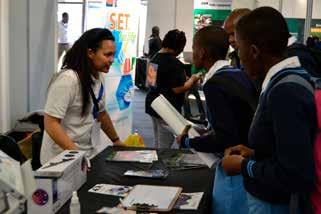
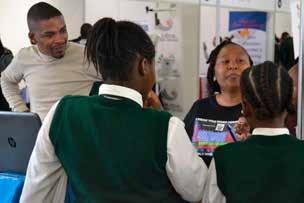
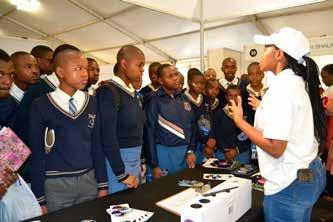
To see more of our exciting trips and pictures, follow us on our social media channels to keep up with the African Science Stars team.
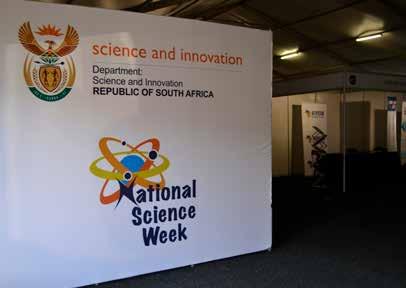
The African Science Stars team was part of the Town meeting that took place at the SAAO Auditorium. This two-day meeting was based on what can be done to fill the implementation plan towards the GA 2024, the benefit of human kind in astronomy and grants offered in this field.

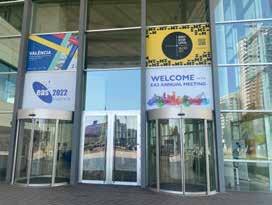
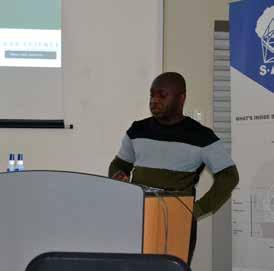
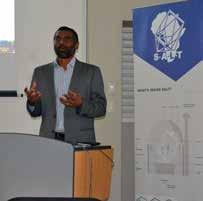
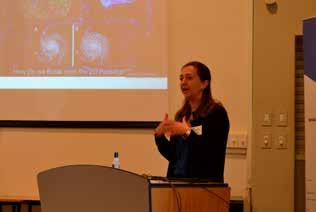


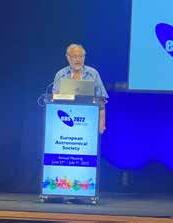
African Science Stars attended the annual European Astronomical Society Conference (EAS2022), which took place in Valencia, Spain. The five-day meeting was meant to establish links between international communities and strengthen existing networks. The African Astronomical Society (AfAS) and the African Planetarium Association (APA) were also in attendance.

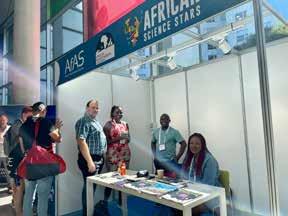
RESEARCHERS FROM AROUND THE GLOBE MEET AT ASTRONOMY AND SPACE SCIENCE EVENTS TO LEARN AND DISCUSS POTENTIAL SOLUTIONS TO PRESSING PROBLEMS.
THE ASTRONOMICAL SOCIETY OF SOUTHERN AFRICA (ASSA) SYMPOSIUM 2022: CELEBRATING A CENTENARY
Where: Cape Town, South Africa
When: 12- 16 October 2022
For more details: Go to the ASSA website
The Astronomical Society of Southern Africa will host a birthday symposium that will bring amateur astronomers and profession als from across South Africa. The symposium will be filled with inspirational presentations and discussions from a wide range of topics reflecting on ASSA’s achievements over the past 100 years. Participants will have an opportunity to go on a tour around the observatory to learn about the rich history and see the new visitor’s centre. A R250 fee pp will be required for those that will be attending. For more information visit the ASSA website.
THE 13TH AARSE INTERNATIONAL CONFERENCE (AARSE 2022)
Where: Kigali, Rwanda
When: 24-28 October 2022
For more details: www.aarse2022.org
This conference is aimed at bringing together scholars and practitioners from African and international communities to pres ent the latest scientific advances, discuss challenges. It involves sharing experiences regarding space and geospatial technologies. This event isorganised by the Institut d’Enseignement Superieur de Ruhengeri (Ines-Ruhengeri) and the African Association of Remote Sensing of the Environment under the theme “space and geospatial technologies for the Africa we want. The primary objective is to raise awareness of the benefits and empowering effects of developing, applying and responsibly utilising Earth
Observation Systems and Geo-information Technology to African governments and their institutions, the private sector, and soci ety in general.
APPLICATIONS FOR THE 6TH AFRICAN SPACE GENERATION WORKSHOP (6TH AF-SGW) ARE NOW OPEN!
Where: International University of Rabat Campus (UIR), Rabat, Morocco
When: 25 - 26 November
For more information: delegates-afsgw@spacegeneration.org
The International University of Rabat brings a two-day workshop for students, young professionals, industry experts and govern ment stakeholders from across Africa to discuss innovative and regional challenges related to the African space sector. Under the theme “#Space4Africa for a more prosperous continent” this event will provide an excellent opportunity to discuss innovative ideas and challenges relating to the African space sector.
Working groups (WG) will be formed with each focusing on a specific sub-theme, such as Space Education and Outreach, Space Law and Policy, Space Business, Space Systems and Technology, Big Data and Quantum Technology in GIS, among others. Attending this event will provide you with the oppor tunity to learn, exchange knowledge, and network with young professionals.
Where: NASRDA Headquarters, Lugbe, Abuja
When: 22-25 November 2022
For more information: Register: https://www.lautechnanotech.com/files/conference_reg ister.php
In collaboration with the National Space Research and Development Agency (NASRDA), the Nanotechnology Research Group at Ladoke Akintola University of Technology (LAUTECH), Ogbomoso, Nigeria, will organise the 6th International Conference on Nanotechnology in Lugbe, Abuja. Under the theme “Nanotechnology for Socio-Economic Development of Africa” participants will learn various techniques in Nanotechnology. Participants will also be exposed to current trends in nanotech nology research, where and how to infuse nanotechnology in their research activities.
Job level: Management
Location: Cape Town, Western Cape
Contract Type: Permanent
Duties
• To provide project management ser vices to SARAO programme managers and management in the execution of built environment projects to sup port the construction of major radio astronomy facilities.
• To provide project management sup port to more junior Project Managers.
• To manage built environment projects through the full project lifecycle (ini tiation, planning, execution, control/ monitoring, closing) according to established SARAO procedures.
• Creating all project management arte facts as required (Project Management and ancillary plans, budgets, sched ules, reports).
Qualification:
Bachelor’s degree in Engineering 8 years’ experience in a project management role Registration in ECSA, ASAQS or equivalent professional registration
Experience:
Managing large-scale built environment projects
Extensive experience in Contract Management according to NEC4
(preferred), NEC3 and FIDIC
A Project Management Office environment
Sound experience with project planning tools (Primavera, MS Project)
SANSA
Location: Hermanus
Duties:
• Provide support as required to all SANSA infrastructure/measuring sites.
• Perform installations and maintain instrumentation (including remote sites).
• Source and procure electronic compo nents for unit projects.
• Work with Embedded systems, includ ing microcontrollers as well as IoT devices.
• Help develop and assemble custom electronic subsystems for EDA projects.
• Provide electronics support to internal and external clients.
• Training staff members and students.
Requirements:
• Must have a BTech Electrical Engineering or similar qualification.
• 3-5 years’ experience in an electronics hardware environment.
• Have previous experience in pcb design and fabrication.
• Be familiar with embedded systems.
• Have knowledge of and previous experience working on Linux-based operating systems.
Please note there will be a background verification:
• criminal record
• credit checks
• security clearances
• qualification
• citizenship checks
• competency assessment and psychometric testing
Should you meet the above requirements, please register your detailed CV and cover letter on the following: current opportuni ties – sansa.mcidirecthire.com / https:// sansajobs.mcidirecthire.com
Regularly check the NRF/SARAO, SARAO and SANSA websites for more job open ings. They are updated regularly. Currently they are advertising vacancies for:
• Systems Engineer
• Senior System Engineer
• Senior Systems Analyst
• Project Manager
These jobs require the following skills:
• Decisiveness
• The ability to communicate effectively, both verbally and in writing.
• Good analytical and planning skills
• Efficiency in a high-pressure environment.
• Willingness to work outside normal hours.
• Proactive.
• Ability to deal with uncertain environ ments and reduce uncertainty.
Problem solving.
